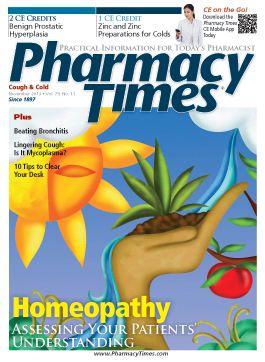Publication
Article
Pharmacy Times
Case Studies
Case studies involving patients with influenza or in close proximity to patients with influenza.
Case 1
RM is a 55-year-old woman who comes to your pharmacy for an influenza vaccination. She works as a nurse in a hospital transplant unit. She is healthy (no acute or chronic conditions) and takes no medications. She recently heard that your pharmacy offers the nasal vaccine FluMist (MedImmune), and she would like to receive it.
As RM’s pharmacist, should you administer the nasal spray vaccination to RM?
Case 2
MC is a 35-year-old Hispanic woman who comes to your pharmacy with a prescription for oseltamivir (Tamiflu, Genentech). She lives with her sister, who was diagnosed with influenza this morning, and has been in close contact with her. MC has never been vaccinated and has a newborn at home. She informs you that she would like to get vaccinated with the FluMist (MedImmune) nasal spray today and have her prescription for oseltamivir filled.
As MC’s pharmacist, do you fill the prescription in conjunction with administering the nasal spray flu vaccine?
ANSWERS
Case 1: RM is not an eligible patient for the nasal spray vaccine because she is older than 50 years. Moreover, because RM works in a hospital transplant unit, additional considerations apply.
The nasal spray vaccination is a live attenuated influenza vaccine approved for healthy patients aged 2 to 49 years who are not pregnant. According to the Centers for Disease Control and Prevention (CDC), people should not be vaccinated with the nasal spray if they are younger than 2 years or 50 years or older, have a chronic disease (particularly one that places them at high risk for complications from influenza, including chronic heart or lung disease, diabetes mellitus, or kidney failure), have a weakened immune system or are on immunosuppressants, are severely allergic to eggs, have a history ofGuillain-Barré syndrome, are younger than 5 years with a history of recurrent wheezing, or are children or adolescents receiving aspirin.
Although RM is not a candidate for the nasal vaccine because of her age, the pharmacist should also strongly consider RM’s job as a hospital transplant unit nurse in the decision-making process. As a health care professional who has frequent contact with immunocompromised patients, RM should not receive the nasal spray vaccine or should avoid contact with immunocompromised patients for 7 days after receiving it, per CDC recommendations. As this might interfere with her work schedule, the inactivated intramuscular or subvirion (intradermal) influenza injection is preferred
Case 2: The pharmacist should fill the prescription for oseltamivir, but not administer the nasal influenza vaccine (FluMist, MedImmune).
Anti-influenza (viral) prophylaxis is recommended for persons in households where one family member is at high risk of complications secondary to infection (ie, MC’s unvaccinated infant). However, anti-influenza antiviral drugs can inhibit replication of the live vaccine virus and may decrease the effectiveness of the live attenuated influenza vaccine nasal vaccine. For this reason, it is recommended that the patient wait at least 48 hours after the last dose of antiviral medication before receiving the nasal spray influenza vaccine. Alternatively, MC and other members of the household who have not yet been vaccinated can receive the inactivated influenza vaccine either intramuscularly or intradermally (Fluzone, Sanofi Pasteur; Fluvirin, Novartis) in conjunction with oseltamivir.
function showAnswer() {document.getElementById("answer").style.display = 'block';document.getElementById("link").style.display = 'none';}
Ms. Meng is a PharmD candidate, Dr. Mearns is a health economics and outcomes research fellow at Hartford Hospital Evidence-Based Practice Center, and Dr. Coleman is professor of pharmacy practice, as well as co-director and methods-chief at Hartford Hospital Evidence-Based Practice Center at the University of Connecticut School of Pharmacy.







